"The Children of the Corn"
Article and photos by Rachel
Flemming
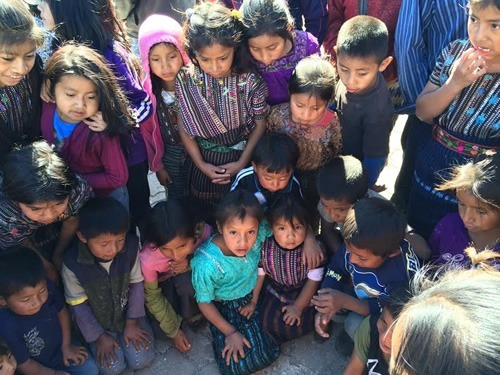
|
|
Mayan children in Guatemala are playing
a game.
|
My heart started to race the first time
I saw a young boy walking down the highway alone. He might
have been four or five years old, and stumbled along the
road less than five feet from the many chicken buses, motorcycles,
and tuk-tuks — all racing to their destinations passing
by his left side. He had been watching us work from his
house in the distance for some time, peering through the
fields of corn stalks over seven feet high. He wanted to
see what these gringos in their tourist vans were
doing at his neighbor’s house. The young boy slowly emerged
once he laid eyes on the toys we were giving out to some
of the other neighborhood children. I offered him a new
soccer ball so he could play fútbol with his friends.
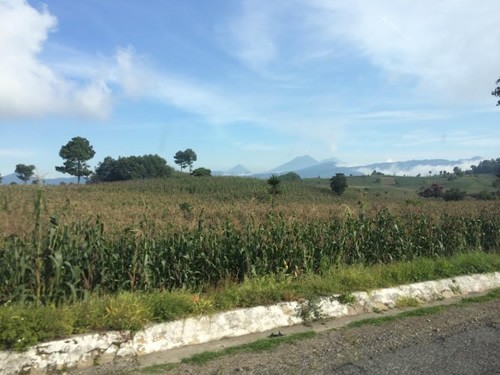
|
|
Cornstalk fields with Volcano
Agua in the background.
|
I sent the child on his way back home, but a few moments later, he reappeared on the road carrying a 100-quetzal bill and a scribbled grocery list. At first, I thought he was trying to pay for the ball, which I intended to refuse because it had been my gift. In my broken Spanish, I asked what he was doing, and he, in his broken, Mayan Spanish, replied, “Buying food for Mamá.” A convenience store awaited him with bread and milk a mile away, so I let him go. I watched as he set off, walking the fine line between being hit by a truck and falling in the polluted ditch beside him. Slightly nervous, I wondered if I should hold his hand and walk with him.
It would not be the last time I felt those anxious palpitations over the precarious situations in which young Guatemalans often find themselves. From the first moments in that impoverished country, I realized it would be necessary to suppress my desire to control and my protective instinct, refined through 10 years of experience as an American childcare provider. Children roamed the streets in Guatemala the same way as adults, running around, taking care of other children, and often working just as hard or more challenging to provide some small income for their families.
In one of my earliest moments of horror, I saw a mother ascend into a van, which served as our shuttle. Her toddler stood by her feet, and her infant breastfed openly as we sped through town with the van door wide open. In shock, I looked away, trying to collect my emotions as images of traffic accidents and thoughts about the ignorance of it all flooded my head. I commented to Suzi, my Latina friend and guide, that such behavior would never be legal in the United States, where seatbelts are mandatory, and all children must be secured in weight-appropriate car seats.
“Guatemalan children are raised in the
"school of hard knocks," as you Americans say,” she replied
to my frightened — and frankly upset — declarations.
“Safety regulations and child labor laws would be laughed
at in a community like this. Poverty and desperation alter
the way a person thinks about the types of security they
actually need.”
The Effects of Historical Colonialism
What Suzi said to me was true for much of the Latino population in Guatemala. Still, it was even truer for the Mayan people. The contemporary indigenous population was still reeling from the lingering effects of monstrous, oppressive historical colonialism. Untrained and inefficient farming, selling their heritage as a tourist tote bag, were two of just a handful of modern-day Mayan trades. Very few locals ever had access to opportunities for advancement. Families needed income, and the children were often enlisted to help as well. Shoe shining, begging from passersby, and selling jewelry to tourists were ordinary sights in any Guatemalan city big enough for a hotel. I met Mayan children daily on the streets, not in schools, trying to sell me scarves or boat tickets.
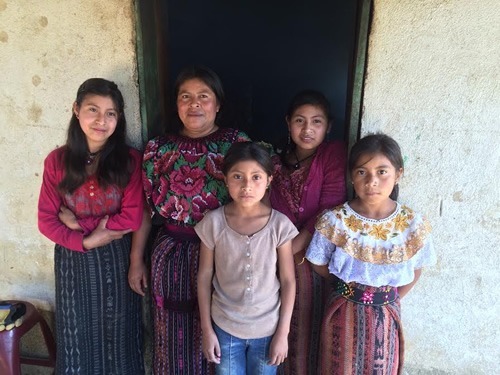
|
|
A Mayan family in traditional
clothing.
|
One would offer, “Señorita, 20 quetzals, and I will take you to Volcano San Pedro.”
“No, thank you. I’m looking for someone else,” I would say, though I was just looking for a better deal.
“15 quetzals, amiga. It’s a
special price just for you.”
“10 quetzals, and no stops,” I told the 9-year-old. The child looked back at his father, who nodded sadly and approvingly simultaneously. I climbed in the boat, heading across the lake to hike the grand volcano, saddened by the realization that I had just spent two minutes arguing over the equivalent of a little over one U.S. dollar with a boy half my height.
As the boy sat on the edge of the motorboat, I worried that he would fall off. Can he swim? Why are there no life jackets on the boat? What if we capsize? We are in the middle of a 30-mile-long lake, for crying out loud! Yet such worries never appeared on his round face, and he seemed wholly unfazed by any thoughts about potential dangers for our trip. Absorbed in the sight of the mountains surrounding the pristine waters, he stared directly ahead, past the grand volcano, and into the clouds. The smiling boy with his wind-blown hair was also one of the few I came across who had the chance to work closely with his father, and I realized how lucky he must have considered himself. He also did not have the luxury of time for any anxieties.

|
|
Panajachel, Lake Atitlán, and
Volcano San Pedro.
|
In general, I found the Mayan people to be some of the most grateful I had ever met, and because of that, some of the most content. The older generations did carry, at times, the grief of poverty, oppression, and a sense of exhaustion deep in their souls. When I paid attention, I could see it in the lines of their face as they smiled with only gums for grins. Ancient racial tensions could still be felt between the Latinos and the Mayans. In many places, the divide echoed the feeling of America before the Civil Rights Movement. Despite this, Mayan joy remained intact, not because it was founded on their present economic circumstances or living conditions, but because it stemmed from their heritage's richness.
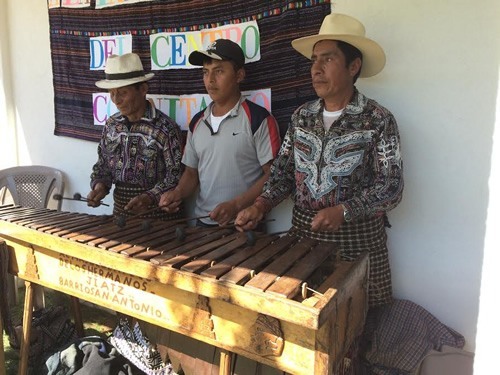
|
|
Mayan men playing the Marimba.
|
The Mayans are the People of the Corn
The Mayans are the people of the corn. In the beginning, they say that the gods tried to make them out of clay and later out of wood. Neither of those materials, however, could facilitate a sufficient capacity for love and tranquility. Therefore, the gods ultimately made the Mayans from corn, an abundant substance full of nourishment and versatile in its many functions. Because tortillas and tamalitos were regular but sacred foods, young girls in their brilliant, hand-woven blouses and skirts must learn to make them from an early age. On every street, you could hear the slapping sound of tortilla shops celebrating the pervasive cooking culture. In fact, I could only travel to a town around the lake by running into a variant of these practices, prized by the people who still fought modernity to ensure the survival of their history. This very history and the pride they took in it encouraged every Mayan face to smile. This same history also protected the little children, even though their endless running and flying about could make an outsider anxious.
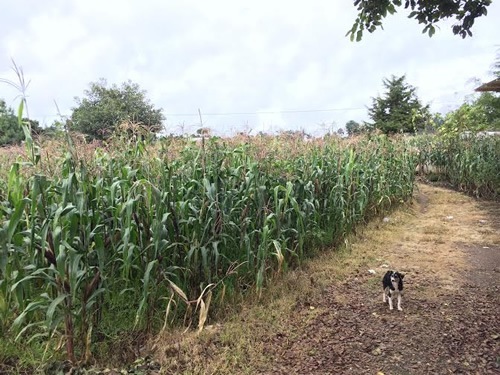
|
|
Fields of cornstalk.
|
Out of all the children I met and with whom I worked, Fernando terrified me most frequently. Perhaps it was because I saw him more regularly than many other children. It could be because all my interactions with him occurred at the construction site where we were building his new home, in a small village called Chutiestancia, just around the corner from the boy walking on the road. On the other hand, perhaps it was because I saw in his eyes the same thrill-seeking spirit I felt in my own heart but frightened me in children. We connected over the rush of adrenaline during our adventures. We also developed a bond due to the novelty of contact between people from different cultures. I felt apprehensive about letting a child run free at five years old, with no father and no apparent rules to protect him. So Fernando's darting, dashing, jumping, and swinging resulted in anxious butterflies that overwhelmed my stomach during the first few days in the community.
I never called him Fernando but instead christened him “Monito,” or “Little Monkey,” because he climbed on people as he climbed on trees. Full of more energy than any of our volunteers, he would incessantly run around our site as we worked, helping with whatever he could and getting in the way of whatever he was too small to do. Often, I would be shoveling or sifting sand and suddenly feel two arms wrapped around my neck, shouting the Spanish version of my name, asking me to pick him up and help him fly.
Monito’s grasp of Spanish was no better than mine. His first language was Kakchiquel, an ancient Mayan dialect that I came to associate with frequent use of the sounds of “u,” “z,” and “k.” Because his mother knew very little Spanish, he spoke with her in the indigenous tongue, only switching over to Spanish when he spoke with me.
“I want to help you build,” he would state firmly, calloused hands outstretched for a bucket full of concrete.
“You are too small to help with this,
Monito,” I replied. “It’s too heavy.”
“I am not. I am strong,” Monito asserted indignantly. I had to reduce the amount of grey slush I put in the bucket for him to lift it, as his little arms could only carry about a fourth of the amount adults could safely handle. Even so, he could barely move it off the ground, and often, he would ask for another job.
“Okay, I have an idea. You carry back
the empty buckets for us to fill with the concrete.”
Monito quickly enlisted the help of his sister, Rosa, and cousin, Juana. Together, they formed an empty bucket brigade that moved quicker than our own line, which was three times as long and comprised solely of adults. Despite how quickly they ran to retrieve the buckets and bring them back to be refilled, they never seemed to tire. And despite such poverty, filth, and hard work, the happiness in their toothless smiles seemed to me beyond all possibility of ever fading.
I thought of child labor laws and construction site regulations again and how “none of this would be legal in the States.” I had 6-year-olds running around my legs while I tried to cut concrete blocks with a machete. Sometimes, they left their shoes, and even though they already had holes in their pants, they insisted on rolling in the gravel right next to the giant pila sink I was trying to destroy with a sledgehammer or on leaping off of the half-constructed walls of cinder blocks into a mound of dirt next to the sewage drain.
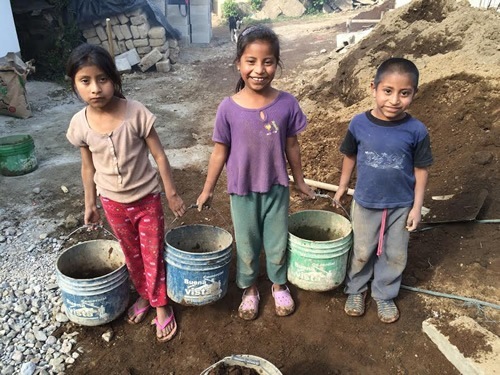
|
|
Juana, Rosa, and Fernando are moving
empty buckets.
|
About three weeks into our work, Monito decided he wanted to take a break from working with us to play a game I call “Dodge the Semi-Truck in the Road While Flying Your New Kite.”
“If I can’t fly, at least my kite can!” he declared, racing up the dirt road, taking the shortcut through the fields of corn wrapped with beans from the new harvest. I chased him as fast as I could, finally reaching him as he ran down the open highway. He would not listen to my rebukes or to my commands. When I told his mother, she remained completely unalarmed.
“He will be fine,” she said to calm my anxieties as she flipped his lunch of tortillas on the wood-fired stove. “He always is.”
Her affirmation did little to quell my nervousness. As I watched him run down the road, I tried to keep up with him, stopping with my heart pounding just as I saw a semi-truck begin to come down the hill.
“Monito, carro! Be careful, there’s a carro!” My Spanish failed me amid my panic, but somehow he still understood. Calmly, he walked back to me, waited for the truck to pass, and immediately darted out again to fly his kite. He looked back at me, smiled his little monkey grin, and ran again to catch the air beneath the kite. I knew then that more than his kite was soaring — his spirit was also in the sky.
Little could dampen the enthusiasm and excitement I encountered in the Mayan children. Of course, they knew the sadness of hunger and domestic abuse as a part of their lives. Nevertheless, during my time with the children, they were well cared for, played with, and fed. Many disassociated their time at home from their time spent playing with foreigners. Monito, for instance, knew what he must not do around his grandfather to avoid a corn-stalk beating, and he knew his own limitations and capacity for dangerous situations. However, he knew nothing about abstract social laws that might forbid him from playing as he desired in other countries.
For weeks, I traveled from village to village around the highlands of Guatemala, working with children from San Marcos, San Lucas Toliman, Godinez, and Xela. Many of them had never seen an American in person. They likely found me strangely pale and tall, given that the Mayan people tend to run on the shorter and darker side of the spectrum. They would stare at me with brilliant gazes, whispering and giggling in native tongues. Sometimes, even with my knowledge of Spanish, I could not communicate with them because they only spoke Tz'utujil or K'iche'.
“Hola, how are you?” I would
ask the children, only to be met by their wide eyes even
as they looked back and forth at each other, checking to
see if anyone else understood what I had said.
“Do you know what I am saying?” I asked,
met again by confused looks.
“Español?” I finally asked, to which I finally received the small response of a negative headshake.
“Tz'utujil?” I questioned, met this time with enthusiastic nods of approval.
Unfortunately, I knew no Tz'utujil nor any other Mayan dialect. Frustration was my initial response since I had worked hard on my Spanish to avoid these situations. I wondered how to communicate with these children without the capability to share any of the exact words. Over time, however, I found that relationships and playful enthusiasm grant the ability to communicate and share across cultures and languages. We didn’t give up on working with each other, and in the end, we found common signs and signals — our own new language — to use in our games.
I realized during that time that the wonder and joy of children are not the properties of American wealth and security. I had always imagined that one must work hard to perpetuate the “magic of childhood.” Disney World vacations, princess-themed birthday parties, and all the latest gadgets were how many families I had worked for communicated love to their children. Watching Little Einstein or Dora the Explorer on TV was said to foster the creative capacity of children and encourage them to go out and discover the world on their own — as soon as they finally decided to leave the LED screen behind.
I realized that I had yet to be taught holds up. Even though these Mayan children might never have seen a movie and never worn anything other than their traditional attire, without underwear or shoes, a life lived gratefully enhanced the capacity to enjoy the lives they were actually given. I realized that even though I often felt anxious, wondering whether these children were safe or warm enough, they didn’t need me to show them how to love or find beauty in life. I could offer my service to them and their families. Regardless, I could not fabricate what they already possessed inside themselves. In the end, I learned from them. I learned to open my heart to the art of contentment from the wide-eyed children. And I learned to live according to one of their most popular adages: "If you are happy, I am happy. If you are not happy, I am still happy."
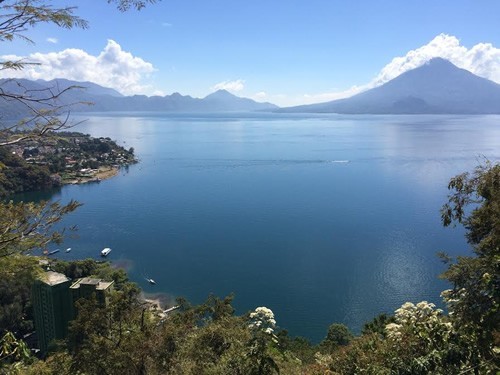
|
|
Beautiful Lake Atitlán with Volcano
Toliman in the distance.
|
Rachel Flemming lives in Florida. She received her Bachelor of Arts degree in English Literature and Spanish. She and her husband both work in language education and hope to continue traveling in Central and South America for work and humanitarian outreach.
|
